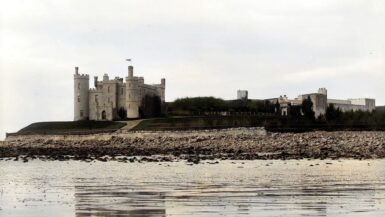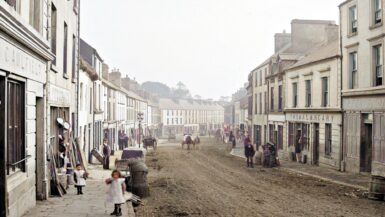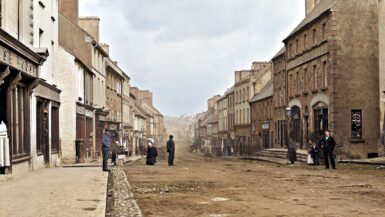ACHILL, a parish, in the union of Westport. barony of Burrishoole, county of Mayo, and province of Connaught, 14 miles (W.) from Newport-Mayo; containing 6392 inhabitants. This district comprehends
the islands of Achill and Achillbeg, and the peninsula of Coraan Achill; comprising 51,521* statute acres,
whereof 35,283$ are in the island of Achill. The island of Achill, which is the largest off the Irish coast, is
situated in the Atlantic Ocean, and is separated from the main land by a narrow sound the southern part of
which, at a place called Mollyranney, is fordable at low water. It is bounded on the north by Black-nod, and on the south by Clew bay, and is 16 miles in length and about 7 miles in breadth, forming a line of coast about 80 miles in circuit ; the lands are chiefly the property of Sir Richard A. O’Donnell, Bart., but partly belong to the Marquess of Sligo. The western side is mostly a precipitous range of cliffs, but the eastern is in every part well sheltered. Achill Head, a bold promontory, is situated on the south-western, extremity of the island, in lat. 53° 58′ 30″ (N.), and Ion. 10° 12′ 20″ (W.) ; and at the northern extremity is Saddle Head, at the entrance of Blacksod bay. Between this and the smaller island of Achillbeg, which is described under its own head, is a channel called Achill Hole, where vessels drawing ten or twelve feet of water may ride in safety iu all states of the weather. The peninsula of Coraan Achill, or the Reaping Hook of Achill, lies to the east of the island, and is connected with the main land by the narrow isthmus of Mollyranney ; a powerful tide runs in the sound, at the narrows called the Bull’s Mouth.
The surface of Achill is very elevated, rising into eminences the highest of which is the hill of Slievemore,
2204 feet above the level of the sea ; there is but little arable land, and this is chiefly in the valleys and near
the shore. In addition to the mountain of Slievemore, are Menaun hill and Croaghaun, on one of which is a
precipice rising abruptly from the sea to the height of 2000 feet : the magnificence of the view from this eminence is unrivalled on the coast of Ireland. Till within the last 25 years there were no roads in this retired district. Of late, however, and especially since the Protestant mission, supported by zealous churchmen, was instituted in 1634, great improvements have taken place : a superior style of building has been introduced, and a better system of agriculture promoted. A regular ferry, with landing-places, has been established at the sound, which is about a mile across ; there is an hotel for the accommodation of travelers ; and a court of petty-sessions is held. An excellent hotel has also been opened at the Missionary settlement, where is a post-office ; and the mail-car which runs from Newport every Tuesday, Thursday, and Friday, and back again on the other days, affords a cheap and expeditious conveyance to tourists wishing to visit this interesting district. Keel is a coast-guard station, as is likewise Dugort. The living is a rectory in the diocese of Tuam, and in the patronage of the Bishop : the tithe rent-charge is £70. There is no parish church ; but divine service is performed at the Missionary settlement at Dugort twice every Sunday, in the English and Irish languages. In the Roman Catholic divisions, Achill forms a separate and distinct parish, and there arc two chapels, one at Kildavenet and the other at Dookenelly. At the Missionary settlement is an orphan institution, where 100 children of the Roman Catholic persuasion are maintained, and educated in the Protestant faith ; there is also an asylum for converted Roman Catholic priests of
good character. Another branch of this establishment has lately been planted in the valley of Meelon, six
miles distant from the present settlement, and where a church, minister’s residence, and school-house have been erected. There arc four National schools in the parish, and six schools supported by the Achill mission. A paper, called the Achill Missionary Register, is published monthly. There are remains of old churches, with burial-grounds attached, at Kildavenet and Slievemore; and at the former place are also remains of an ancient castle, which originally belonged to the well-known Grace O’Malley.
Extract from: Lewis – A Topographical Dictionary of Ireland





Leave a reply